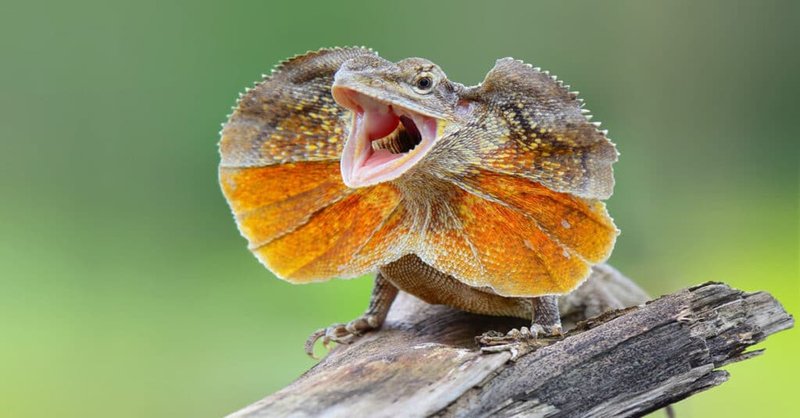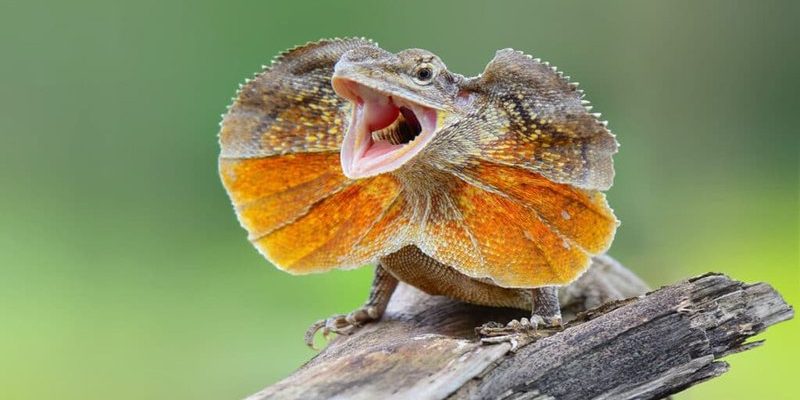
Just like a good supporting actor in a film, the frilled lizard has a unique part to play in the circle of life. By catching insects, they help control pest populations, and their presence also indicates a healthy environment. Let’s dive deeper into the world of the frilled lizard and explore its role in the ecosystem, its interactions with other species, and why it’s important to protect these incredible reptiles.
What Is a Frilled Lizard?
You might be wondering what specifically sets the frilled lizard apart from other lizards. These reptiles are known for their impressive frill, which is a fold of skin around their neck that can be expanded dramatically when threatened or during courtship. This frill, often colored brightly or patterned, serves not just as a defense mechanism but also as a means of communication. A frilled lizard can extend its frill to appear larger and more intimidating to predators, kind of like how a peacock fans its feathers to attract a mate.
Frilled lizards are typically found in forests and woodlands where they can easily climb trees. They’re excellent at blending into their surroundings, thanks to their colors and patterns that mimic the bark and foliage of trees. As they move stealthily through the branches, you might miss them if they’re not in full display! They have a diet primarily consisting of insects and small invertebrates, making them important contributors to their food web.
The Frilled Lizard’s Dietary Role
Here’s the thing: frilled lizards are more than just cool to look at; they play an essential role in controlling insect populations. By devouring insects like ants, beetles, and termites, they help keep these populations in check. If there were too many of these pests, they could damage plants, disrupt the ecosystem, and even affect other animal species that rely on those plants for food or shelter.
But it doesn’t stop there. As frilled lizards consume these insects, they also serve as prey for larger animals such as birds of prey and snakes. This makes them a critical link in the food chain. If frilled lizards were to disappear from their ecosystems, it could lead to an imbalance, with insect populations exploding and predator species struggling to find enough food.
Habitat and Distribution
Frilled lizards are primarily found in the humid forests of Northern Australia and New Guinea. Their preferred habitats are the canopy areas and trees, which provide ample space for climbing and hunting.
Why is this habitat important? Well, healthy forests contribute significantly to the global ecosystem by producing oxygen, sequestering carbon, and providing habitat for countless species. By thriving in these environments, frilled lizards not only help keep insect populations in check but also act as indicators of forest health. If frilled lizards are flourishing, it usually means that the forest ecosystem is healthy, making them crucial to biodiversity.
However, their habitat is under threat due to deforestation and climate change. As trees are cut down, frilled lizard populations could decline, leading to broader ecological consequences. Protecting their habitat is vital for maintaining the balance within their ecosystems.
Predators and Threats
Every creature has its share of natural enemies, and the frilled lizard is no exception. They face threats from larger predators like hawks, snakes, and even domestic cats. This constant threat of predation has shaped their behavior and characteristics over time.
To avoid becoming a meal, frilled lizards have developed clever survival strategies. Besides their well-known frill display to scare off predators, these lizards are excellent at climbing and hiding among branches. They can remain motionless for long periods, waiting patiently until the coast is clear.
However, it’s not just natural predators that pose a threat. Human activities like habitat destruction and pollution are significant dangers as well. The loss of trees removes their hunting grounds and refuge, so conservation efforts are crucial to their survival.
The Importance of Conservation
You might be wondering why we should care about protecting the frilled lizard and its habitat. For one, they’re a vital component of their ecosystems. By maintaining healthy insect populations and being a food source for larger predators, they contribute to a balanced ecosystem.
But it’s not just about one species. The health of frilled lizard populations can reflect the overall health of their habitats. Conserving frilled lizards and their ecosystems can have ripple effects, helping protect other species and the environment as a whole.
Efforts to conserve their habitats include creating protected areas, promoting sustainable forestry, and educating local communities about the importance of preserving biodiversity. Every little action counts when it comes to ensuring that frilled lizards, and the ecosystems they inhabit, remain healthy for generations to come.
The frilled lizard is more than just a fascinating creature with a stunning display. It plays a vital role in its ecosystem, acting as both a predator and prey, while also helping maintain the delicate balance in its forest home. Understanding their role helps us appreciate the interconnectedness of life and the importance of conservation.
So, the next time you see a frilled lizard—whether in pictures or at a zoo—remember that it’s not just a cool reptile, but a critical player in its environment. Protecting these unique lizards means protecting the ecosystems they represent. By doing so, we’re not just saving a species—we’re helping to keep our planet healthy and vibrant.

